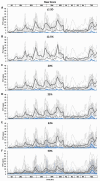Concordance of multiple methods to define resiliency and vulnerability to sleep loss depends on Psychomotor Vigilance Test metric
- PMID: 34624897
- PMCID: PMC8754491
- DOI: 10.1093/sleep/zsab249
Concordance of multiple methods to define resiliency and vulnerability to sleep loss depends on Psychomotor Vigilance Test metric
Abstract
Study objectives: Sleep restriction (SR) and total sleep deprivation (TSD) reveal well-established individual differences in Psychomotor Vigilance Test (PVT) performance. While prior studies have used different methods to categorize such resiliency/vulnerability, none have systematically investigated whether these methods categorize individuals similarly.
Methods: Forty-one adults participated in a 13-day laboratory study consisting of two baseline, five SR, four recovery, and one 36 h TSD night. The PVT was administered every 2 h during wakefulness. Three approaches (Raw Score [average SR performance], Change from Baseline [average SR minus average baseline performance], and Variance [intraindividual variance of SR performance]), and within each approach, six thresholds (±1 standard deviation and the best/worst performing 12.5%, 20%, 25%, 33%, and 50%) classified Resilient/Vulnerable groups. Kendall's tau-b correlations examined the concordance of group categorizations of approaches within and between PVT lapses and 1/reaction time (RT). Bias-corrected and accelerated bootstrapped t-tests compared group performance.
Results: Correlations comparing the approaches ranged from moderate to perfect for lapses and zero to moderate for 1/RT. Defined by all approaches, the Resilient groups had significantly fewer lapses on nearly all study days. Defined by the Raw Score approach only, the Resilient groups had significantly faster 1/RT on all study days. Between-measures comparisons revealed significant correlations between the Raw Score approach for 1/RT and all approaches for lapses.
Conclusion: The three approaches defining vigilant attention resiliency/vulnerability to sleep loss resulted in groups comprised of similar individuals for PVT lapses but not for 1/RT. Thus, both method and metric selection for defining vigilant attention resiliency/vulnerability to sleep loss is critical.
Keywords: Psychomotor Vigilance Test; baseline; individual differences; recovery; sleep deprivation; variance.
© Sleep Research Society 2021. Published by Oxford University Press on behalf of the Sleep Research Society. All rights reserved. For permissions, please email: journals.permissions@oup.com.
Figures






Similar articles
-
The 3-Minute Psychomotor Vigilance Test Demonstrates Inadequate Convergent Validity Relative to the 10-Minute Psychomotor Vigilance Test Across Sleep Loss and Recovery.Front Neurosci. 2022 Feb 15;16:815697. doi: 10.3389/fnins.2022.815697. eCollection 2022. Front Neurosci. 2022. PMID: 35242006 Free PMC article.
-
Cognitive throughput and working memory raw scores consistently differentiate resilient and vulnerable groups to sleep loss.Sleep. 2021 Dec 10;44(12):zsab197. doi: 10.1093/sleep/zsab197. Sleep. 2021. PMID: 34333658 Free PMC article.
-
Raw scores on subjective sleepiness, fatigue, and vigor metrics consistently define resilience and vulnerability to sleep loss.Sleep. 2022 Jan 11;45(1):zsab228. doi: 10.1093/sleep/zsab228. Sleep. 2022. PMID: 34499166 Free PMC article.
-
Trait-like vulnerability to total and partial sleep loss.Sleep. 2012 Aug 1;35(8):1163-72. doi: 10.5665/sleep.2010. Sleep. 2012. PMID: 22851812 Free PMC article. Clinical Trial.
-
The effect of sleep restriction on cognitive performance in elite cognitive performers: a systematic review.Sleep. 2021 Jul 9;44(7):zsab008. doi: 10.1093/sleep/zsab008. Sleep. 2021. PMID: 33438751 Free PMC article.
Cited by
-
The 3-Minute Psychomotor Vigilance Test Demonstrates Inadequate Convergent Validity Relative to the 10-Minute Psychomotor Vigilance Test Across Sleep Loss and Recovery.Front Neurosci. 2022 Feb 15;16:815697. doi: 10.3389/fnins.2022.815697. eCollection 2022. Front Neurosci. 2022. PMID: 35242006 Free PMC article.
-
Cortisol and C-Reactive Protein Vary During Sleep Loss and Recovery but Are Not Markers of Neurobehavioral Resilience.Front Physiol. 2021 Nov 29;12:782860. doi: 10.3389/fphys.2021.782860. eCollection 2021. Front Physiol. 2021. PMID: 34912243 Free PMC article.
-
Cardiovascular measures display robust phenotypic stability across long-duration intervals involving repeated sleep deprivation and recovery.Front Neurosci. 2023 Jul 20;17:1201637. doi: 10.3389/fnins.2023.1201637. eCollection 2023. Front Neurosci. 2023. PMID: 37547137 Free PMC article.
-
Bidirectional predictors between baseline and recovery sleep measures and cardiovascular measures during sleep deprivation and psychological stress.Physiol Rep. 2025 May;13(10):e70374. doi: 10.14814/phy2.70374. Physiol Rep. 2025. PMID: 40405556 Free PMC article.
-
Comparison of effects of modafinil and caffeine on fatigue-vulnerable and fatigue-resistant aircrew after a limited period of sleep deprivation.Front Physiol. 2024 Jan 8;14:1303758. doi: 10.3389/fphys.2023.1303758. eCollection 2023. Front Physiol. 2024. PMID: 38260091 Free PMC article.
References
-
- Belenky G, et al. . Patterns of performance degradation and restoration during sleep restriction and subsequent recovery: a sleep dose-response study. J Sleep Res. 2003;12(1):1–12. - PubMed
-
- Goel N. Neurobehavioral effects and biomarkers of sleep loss in healthy adults. Curr Neurol Neurosci Rep. 2017;17(11):89. - PubMed
Publication types
MeSH terms
Grants and funding
LinkOut - more resources
Full Text Sources
Research Materials

